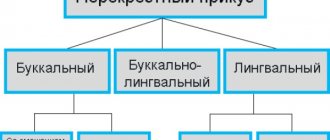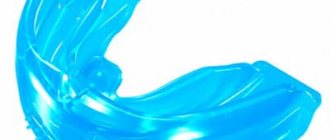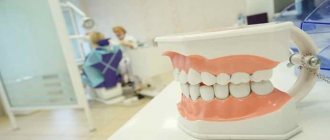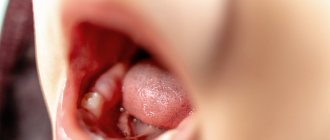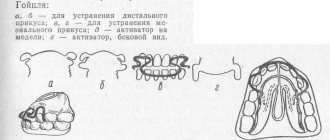An orthodontic positioner is a specialized functional device used in the final stages of correcting malocclusion. The materials used for the manufacture of this device are represented mainly by biocryl, durasoft, bioplast, PM-1 plastic - all of them have soft, bendable, elastic capabilities for changing shape and configuration.
Before removing braces, it is extremely important to assess the reaction of the dental-maxillary system to the removal of elastic arches, and also to ensure that the teeth are in a state of occlusion without assistance. They can help with this:
- Replacing rectangular arches with light ones;
- Using vertical elastic bands after removing braces;
- Using an orthodontic positioner.
Advantages and disadvantages
Among the main advantages of wearing an orthodontic positioner are:
- Earlier possibility of removing braces, in contrast to the installed light arch;
- Active gum massage.
The disadvantages, in turn, are considered:
- Long time for individual production of the device;
- High price;
- Strengthening the incisal overlap negatively affects the deep bite;
- Expanded teeth can return to their original position.
Duration of use
Whether a patient needs a dental positioner will be determined by the attending physician, since he is familiar with all the nuances of the patient’s therapy. Typically, such devices are recommended to be worn after the end of the treatment process. How do they wear?
- During the first 48 hours, the device should remain on the teeth as long as possible.
- When 2 days have passed, the patient switches to constant wearing technology. This means that the device is not removed at all at night, and during the day it is on the chewing organs for at least 4 hours.
- To consolidate the treatment, wearing the device is prescribed for at least 3 weeks. After this, the ego can be removed and used as a removable retention system.
It is important that immediately after removing the bite correction device, the device is ready. Before its installation, professional hygiene and enamel remineralization are carried out. The main thing is that the patient follows all the dentist’s instructions. This is the only way to achieve a good treatment effect. You should definitely visit the dentist twice every 12 months. This is necessary for sanitation of the oral cavity. Patients with problematic occlusion should periodically make appointments with orthodontists. This is necessary to regularly check units that have been adjusted.
How a positioner is manufactured and installed
Individual production of an orthodontic positioner should begin at least 1 month before the expected end of using braces. It is manufactured according to the following plan:
- Taking impressions of teeth that will be corrected;
- Making a plaster model;
- Placing teeth in the desired position;
- Removal of rings and braces;
- Closing and eliminating free space;
- Molding of rubber on models;
- Direct fit to the teeth and installation in the oral cavity.
Only a specialist who is initially involved in correcting the bite of a particular patient and who knows all the details and nuances of the process can determine whether it is necessary to use such a technique or not.
Indications for use
The scope of use of this device is not extensive, since it is less effective than other systems. The device is used:
- If there is an active process of inflammation of the mucous tissues after wearing devices to correct the bite.
- When patients are at high risk of developing open occlusion.
- If the device is recommended as a removable retainer.
With the help of the apparatus, the fangs and incisors move up to three millimeters in the oral direction. The design provides alveolar shortening of one millimeter, and in lateral units - up to two millimeters. The strip allows you to move the chewing organs of the upper jaw by no more than 2 millimeters, and on the lower jaw only by 1 mm. Transparency allows the dentist to identify those areas where compression of the mucous membrane and alveolar process occurs. In such cases, correction is carried out. As an independent therapy technology, this method is recommended for mild anomalies.
In modern orthodontics, ceramic structures and metal braces are most often used. The arc, that is, the power wire, is inserted into the slot hole. It is created from a titanium-nickel alloy. It is activated when it heats up in the patient's mouth, putting constant pressure on the units. This causes them to shift in a given direction. As a result of this impact, units move. The arc pressure is systematically adjusted by the dentist during the dentist's visit.
Preparatory stage
In preparation for the procedure, an individual approach is used, determined by the peculiarities of the anatomical structure of the patient’s jaw. The quality of the correction depends on the accuracy of the readings obtained, so the doctor must competently assess potential risks and pay attention to diagnostic procedures. Dr. Kois's theory identifies five treatment risk conditions, ranging from acceptable functionality to neurological impairment and bruxism. Among the parameters identified during the research, three indicators were identified:
- Joint position;
- Chewing unit ratio;
- Specifics of the operation of the chewing system guide.
To make a diagnosis, a standard questionnaire is used, which includes five points and allows one to assess the severity of changes, as well as draw a conclusion about the presence of signs of dysfunction. In addition, establishing a dialogue between the doctor and the patient contributes to a better understanding of the need to follow recommendations for oral care and calculate the permissible load, which ultimately allows the latter to get rid of constant discomfort.
Manufacturing Features
Preparing a deprogrammer is a multi-stage process, which is determined by the high demands placed on the accuracy of the product. To develop the correct apparatus, it is necessary to take impressions from the upper and lower rows, and then place the plaster models in the articulator. To make a vestibular arch, a wire is used, the configuration of which eliminates contact with the surface of the units. The horseshoe-shaped base is created from polymer and provides a platform for the lower incisors. The finished structure is processed and polished, after which the doctor checks the compliance of the dimensions and tries the device on the dentition. It is worth emphasizing that the contact area should have a narrowed area and affect the midline of one of the frontal elements of the lower section.
The device works the entire time it is in the mouth. The principle of operation is based on registering the occlusion in the correct position and changing the contacts of the teeth. With the help of this device, neuromuscular coordination changes, joint and muscle pain goes away, the functioning of the TMJ improves, and the chewing load is distributed evenly. After two to three weeks of wearing, the discomfort caused by the abnormal development of the TMJ is eliminated, as well as the normalization of sleep and the restoration of the natural state of the jaw region during wakefulness.
Note to parents
How the parents feel about the installation of a removable device determines how the child will feel about this procedure. Adults often make one unforgivable mistake - when they look at the design, surprise appears in their eyes and they ask the question: “How will my child wear this, much less get used to it?” It is clear that after such a reaction, not a single child will want to go to the orthodontist. Therefore, first of all, you need to set yourself up for a positive outcome - high treatment success. This way the child can get used to the device faster.
Removable devices - what are they?
Removable appliances can correct pathologies in the development of teeth and jaws. And they have been doing this for many years. The child grows, and such devices stimulate the natural processes that occur in the body. And you shouldn’t delay treatment, because the sooner it starts, the more effective it will be - this way you can achieve results faster.
The list of removable devices includes mouthguards and trainers. With their help, you can get rid of minor pathology - when there is no need to carry out complex procedures to correct the dentition. We will also highlight Hintz plates and positioners, which also belong to removable devices.
They can be used by people of all ages. Most often they are installed on children, since their jaw anomalies are reversible, therefore, the installation of corrective braces, which must be worn constantly, is not required. Also, such devices are used after serious procedures designed to correct the bite so that the dentition does not shift back.
Removable devices are divided into:
- Single jawed. A person must wear them around the clock, otherwise the treatment will not bring any results. You can take them off while eating, but it’s not necessary. You just need to rinse your mouth after eating so that no food remains remain.
- Double jawed. They must be used at least 12 hours a day during sleep and wear at home.
What defects can adult and children's dental trainers treat?
The main task of the trainer is to correct the following anomalies:
- crowding of the front teeth in the lower jaw;
- deep bite (with the lower dentition overlapping the upper one);
- open bite in the anterior part of the jaw (with non-occlusion of the front teeth);
- non-physiological location of the lower jaw (distal and mesial bite).
When wearing trainers, additional tasks are also solved: speech, swallowing and nasal breathing are normalized, bad childhood habits go away. But it is not always possible to cope with combined anomalies. In such a situation, the choice of orthodontic appliance should be entrusted to the attending physician.
The range of indications for adults, in addition to the above, includes bruxism and excessive gaps between teeth. Trainers with certain advantages are also chosen by patients who categorically refuse to wear braces.
Are there any contraindications to treatment with trainers? Their list is small and, in addition to serious malocclusions, includes non-occlusion of the lateral teeth (crossbite) and constant severe nasal congestion.
Manufacturing
The treatment result and patient comfort depend on the correct manufacturing of the structure, which consists of the following steps:
1. Taking plaster casts of the patient’s jaws and making models of them.
2. Creation of wax templates, supplemented with occlusal ridges.
3. Setting the child’s occlusal parameters.
4. Strengthening the necessary elements (vestibular arch, etc.) on the model placed in the articulator.
5. Adjustment of the device to the patient’s parameters, production of plates.
Indications and contraindications
The greatest effectiveness of correction with an activator acting in three planes is observed in patients under the age of 12 years. During this period, the human skeletal system is in the stage of formation and is easily susceptible to external influence.
Use is indicated for the following occlusal defects:
• Distal. During treatment, the upper part of the apparatus is adjacent to the mesial part of the dentition, the lower part is adjacent to the distal mandibular surface. The arch is placed on the upper incisors, the Coffin spring is placed in the center of the palate (along the seam). The position of the structure directs the mandibular movement along the mesial vector. To prevent the growth of the lower incisors with an external slope, the device is supplemented with a side that overlaps the units by 1/3.
• Mesial. An arc is installed on the lower part of the activator, restraining the growth of the frontal part of the NP.
• Open. For the growth of the lateral alveolar processes, the guides of the apparatus near them are removed. The remaining parts help lengthen this area of the dentition.
• Deep. To separate the bite, parts of the apparatus on the side of the premolars and molars are removed. This stimulates the growth of the lateral alveolar processes.
Wearing the Andresen-Goipl apparatus is contraindicated for the following dysfunctions:
– problems breathing through the nose;
– if you are allergic to the materials of the device.
Advantages and disadvantages
Dentists and patients noted the following advantages of the device:
– the ability to correct many defects. The design corrects occlusal pathologies, sets the tongue in the correct position, and normalizes the activity of the facial muscles;
– treatment is carried out during sleep;
– ease of care. The removable activator is cleaned with a toothbrush and regular toothpaste, rinsed with water, and stored in a container issued by the doctor.
The disadvantages of use include constant monitoring by adults, on which the outcome of treatment depends.
Treatment period
The period of use is set for each patient separately, since it depends on the severity of the pathology and the characteristics of the child. The exact duration of treatment is determined after receiving the first results.
Correcting your bite takes an average of one and a half years. In some cases - from several months to 2-3 years.
Since the device is used only at night, the treatment period may be longer than predicted.
Before starting use, you should consult a pediatrician and an ENT specialist.
Positioner device for x-rays in dentistry
The first devices were developed by Rinn in the 60s. The main parts of the positioner are the sensor holder, the sighting ring, the guide rod and the bite block.
- Sensor holder. Lightweight design consisting of a handle and a flexible clamp, the use of which does not in any way affect the external dimensions of the sensor; increases positioning accuracy and ensures the comfort of the procedure. Using a holder ensures that the X-ray beam hits the sensor at a right angle and, accordingly, obtains an image without distortion. The holder allows you to not set the shooting angle on the X-ray; in addition, the doctor can take a picture of the tooth for the patient in any position.
- Sighting (sighting) ring. Designed for orienting the X-ray tube. The guide rod is installed in a groove (there are several of them, usually marked in different colors, each designed for photographing a certain group of teeth).
- Guide rod. A device through which the sensor holder and the sighting ring interact.
- Biting block. A plate used to take images of the upper periapical zone (the area at the top of the tooth root). Extends the holder and allows you to place the sensor so that the image fully reflects the condition of the root apex and adjacent tissues.
Photographs of the posterior and anterior teeth are taken using different positioners. For the convenience of the specialist performing the x-ray, they have different colors.
Invisible orthodontics
Each positioner is manufactured individually for each patient using state-of-the-art equipment in the USA.
At the center of the technology is a set of individual positioners made of transparent plastic, which are completely invisible when worn. For the entire course of treatment, from 18 to 30 pairs are required. Since the shape of each person’s teeth is purely individual, a set of mouth guards for each patient is also made individually. In this case, very advanced computer technologies are used - computed tomography, three-dimensional modeling, stereolithography (find out more about this!).
The aligners are manufactured in the USA, in the laboratories of Align Technologies, and the initial data for their production are provided by orthodontists who directly treat the patient at the Henry Clark Dental Clinic .
How to choose a doctor?
You need to understand that installing removable appliances to straighten teeth is a complex process that only a professional can carry out. Only a highly qualified specialist who has dealt with anomalies more than once can solve this problem. He will talk about the advantages of this method of treatment, its difficulties, and contraindications. The doctor will discuss suitable devices with the patient. Our dental clinic employs such experienced and qualified specialists.
